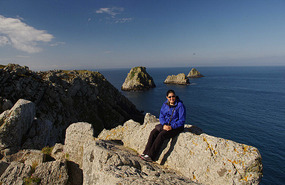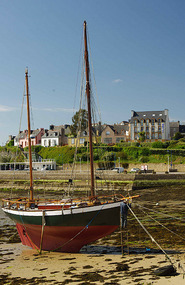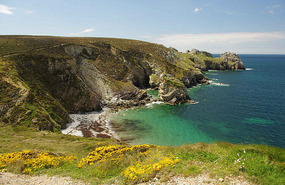It was a beautiful, sunny day out and we were all set to explore some of the coastline on Presqu'ile de Crozon. "Presqu’ile" literally translates to “almost island” and that pretty much describes this anchor-shaped peninsula that juts out from the Brittany mainland. Our first stop was Pointe de Penhir, a few miles south of Camaret (the't’ is surprisingly pronounced). The point has a lone WWII memorial and otherwise is just composed of sheer cliffs, rising about thirty meters above sea level, that form the jagged coastline.
The early morning sunshine and the clear blue skies made for some great photo opportunities and unlimited visibility; the picture where it looks like Megs is sitting on a rock at cliff’s edge is precisely that. We wandered around the point for a bit before heading along the coastline a bit further to the second WWII memorial, dedicated to the mariners. There were real anchors from various war ships lining the entrance to the remains of the coastal bunkers. On beautiful days such as this and with stunning views, I always find it hard to picture this as the setting for a war. Before heading into Camaret, our final stop was at a megalithic alignment of stones, dating from about 2500 B.C. Although so simple in their arrangement, they are still a puzzle today – how were they raised and why? This was just an introduction to what we were going to see at Carnac in a few days time.
Camaret-sur-Mer is a small port town, once frequented for commercial purposes, but now mainly surviving on the tourist trade. In fact, this is essentially the story of most of Brittany’s coastal towns and we have to say that the French sure realize the value of tourism and do their utmost to promote it, while trying to maintain the small-town look and feel. Camaret’s waterfront is lined with colourful buildings, mostly restaurants, hotels and tourist shops.
One street inland, it is home to quite a few artists’ galleries, most of which were closed in the off-season. We did wander into one gallery where the artist was doing etchings and pencil sketchings of rope. The amazing amount of detail he had put into these made the rope seem life-like, like it was right there in front of you. We found a bench by the port to enjoy our picnic lunch of bread and cheese. After lunch, we wandered down to the end of the pier, past the boat graveyard and towards the Vauban tower. Unfortunately, the tower was closed for renovations so we couldn’t enter but we did find an illegally abandoned boat (we knew this because of the solemn notice from the Mairie stapled to its hull) that was great for close-up photos. From Camaret, we spent the rest of the afternoon checking out more viewpoints at the Pointe de Dinan and the Cap de Chêvre. Pointe de Dinan was much more impressive than the Cap but we had to go the cape because of its name, if for nothing else. Our final stop of the day was at Menez Hom, the highest spot in the region (at a lofty 300 m!), from where we got nice views all around, especially over the Douarnenez bay.
The wind was blowing quite strong up here and we could see why it was so popular with the dozen or so people flying their remote-controlled glider planes. These planes were quite large, with wingspans well over two and a half meters, and they were zipping around above our heads. From there, we drove further south to our campsite in Locronan, which we were planning on visiting the next day. Once again, we were treated to a campsite with an excellent inland view and the best washroom facilities we’ve had on this trip, rivalling that of a hotel.
Beautiful views near Camaret
Wednesday, May 22, 2013
 Camaret-sur-Mer, Brittany, France
Camaret-sur-Mer, Brittany, France
Other Entries
-
126Open Air Museum in Arnhem
Apr 1438 days prior Arnhem, Netherlandsphoto_camera55videocam 0comment 2
Arnhem, Netherlandsphoto_camera55videocam 0comment 2 -
127Amsterdam
Apr 1735 days prior Amsterdam, Netherlandsphoto_camera72videocam 0comment 2
Amsterdam, Netherlandsphoto_camera72videocam 0comment 2 -
128Aalsmeer Flower Auction
Apr 1834 days prior Aalsmeer, Netherlandsphoto_camera47videocam 3comment 0
Aalsmeer, Netherlandsphoto_camera47videocam 3comment 0 -
129Cheese Market in Alkmaar
Apr 1933 days prior Alkmaar, Netherlandsphoto_camera62videocam 0comment 0
Alkmaar, Netherlandsphoto_camera62videocam 0comment 0 -
130The Historic Triangle
Apr 2032 days prior Hoorn, Netherlandsphoto_camera81videocam 2comment 3
Hoorn, Netherlandsphoto_camera81videocam 2comment 3 -
131Fishing Village of Marken
Apr 2131 days prior Marken, Netherlandsphoto_camera21videocam 0comment 1
Marken, Netherlandsphoto_camera21videocam 0comment 1 -
132Edam, Tulips & Windmills
Apr 2230 days prior Lisse, Netherlandsphoto_camera49videocam 0comment 1
Lisse, Netherlandsphoto_camera49videocam 0comment 1 -
133Canal Boating on the Bourgogne
May 0121 days prior Migennes, Francephoto_camera110videocam 5comment 3
Migennes, Francephoto_camera110videocam 5comment 3 -
134Trapped by the Floods
May 0418 days prior Fleurey-sur-Ouche, Francephoto_camera48videocam 1comment 0
Fleurey-sur-Ouche, Francephoto_camera48videocam 1comment 0 -
135Canal Boating on the Lateral Canal to the Loire
May 0913 days prior Briare, Francephoto_camera99videocam 3comment 4
Briare, Francephoto_camera99videocam 3comment 4 -
136Dinan
May 139 days prior Dinan, Francephoto_camera42videocam 0comment 1
Dinan, Francephoto_camera42videocam 0comment 1 -
137Coastal Walk & Saint Malo
May 148 days prior Saint-Malo, Francephoto_camera21videocam 0comment 0
Saint-Malo, Francephoto_camera21videocam 0comment 0 -
138Fort-la-Latte & Cap Frehel
May 157 days prior Fort-la-Latte, Francephoto_camera40videocam 0comment 0
Fort-la-Latte, Francephoto_camera40videocam 0comment 0 -
139Paimpol & the Sillon de Talbert
May 166 days prior Paimpol, Francephoto_camera24videocam 0comment 0
Paimpol, Francephoto_camera24videocam 0comment 0 -
140Île-de-Bréhat
May 175 days prior Île-de-Bréhat, Francephoto_camera74videocam 1comment 0
Île-de-Bréhat, Francephoto_camera74videocam 1comment 0 -
141Bird Spotting and the Pink Granite Coast
May 184 days prior Perros-Guirec, Francephoto_camera56videocam 1comment 0
Perros-Guirec, Francephoto_camera56videocam 1comment 0 -
142Crepes in Roscoff and the Keremma dunes
May 202 days prior Roscoff, Francephoto_camera46videocam 0comment 0
Roscoff, Francephoto_camera46videocam 0comment 0 -
143Beautiful views near Camaret
May 22 Camaret-sur-Mer, Francephoto_camera42videocam 0comment 0
Camaret-sur-Mer, Francephoto_camera42videocam 0comment 0 -
144Crepes in Locronan
May 231 day later Locronan, Francephoto_camera20videocam 0comment 0
Locronan, Francephoto_camera20videocam 0comment 0 -
145Quimper
May 242 days later Quimper, Francephoto_camera22videocam 0comment 0
Quimper, Francephoto_camera22videocam 0comment 0 -
146Artist Village of Pont Aven
May 253 days later Pont-Aven, Francephoto_camera8videocam 0comment 0
Pont-Aven, Francephoto_camera8videocam 0comment 0 -
147A relaxing day in Quiberon
May 264 days later Quiberon, Francephoto_camera15videocam 0comment 0
Quiberon, Francephoto_camera15videocam 0comment 0 -
148Megaliths and Thundershowers
May 286 days later Vannes, Francephoto_camera35videocam 0comment 0
Vannes, Francephoto_camera35videocam 0comment 0 -
149Marais Poitevin
Jun 0110 days later Saint-Hilaire-la-Palud, Francephoto_camera45videocam 1comment 0
Saint-Hilaire-la-Palud, Francephoto_camera45videocam 1comment 0 -
150Ile de Ré
Jun 0312 days later Saint-Martin-de-Ré, Francephoto_camera45videocam 0comment 0
Saint-Martin-de-Ré, Francephoto_camera45videocam 0comment 0 -
151Exploring around Royan
Jun 0615 days later Royan, Francephoto_camera97videocam 0comment 0
Royan, Francephoto_camera97videocam 0comment 0 -
152Sarlat Market, a third visit
Jun 0817 days later Sarlat-la-Canéda, Francephoto_camera50videocam 0comment 0
Sarlat-la-Canéda, Francephoto_camera50videocam 0comment 0 -
153Saint-Cirq-Lapopie and the Cuzals farm museum
Jun 0918 days later Saint-Cirq-Lapopie, Francephoto_camera93videocam 3comment 0
Saint-Cirq-Lapopie, Francephoto_camera93videocam 3comment 0 -
154Millau Viaduct and the Roquefort Caves
Jun 1019 days later Millau, Francephoto_camera37videocam 0comment 0
Millau, Francephoto_camera37videocam 0comment 0 -
155Scenic Drives, Views and Caves near Meyrueis
Jun 1423 days later Meyrueis, Francephoto_camera164videocam 3comment 0
Meyrueis, Francephoto_camera164videocam 3comment 0 -
156Commuting to the Camargue
Jun 1625 days later Saliers par Arles, Francephoto_camera85videocam 0comment 2
Saliers par Arles, Francephoto_camera85videocam 0comment 2 -
157Exploring the Chateau in Les Baux
Jun 1726 days later Les Baux de Provence, Francephoto_camera55videocam 0comment 1
Les Baux de Provence, Francephoto_camera55videocam 0comment 1 -
158Perched Village of Gordes
Jun 2029 days later Gordes, Francephoto_camera45videocam 0comment 0
Gordes, Francephoto_camera45videocam 0comment 0 -
159Great Market, Incredible Ice Cream & Amazing Views
Jun 2130 days later Lourmarin, Francephoto_camera42videocam 0comment 0
Lourmarin, Francephoto_camera42videocam 0comment 0 -
160Ochre Quarry in Roussillon
Jun 2231 days later Roussillon, Francephoto_camera77videocam 0comment 0
Roussillon, Francephoto_camera77videocam 0comment 0 -
161Sunday Market and Waterwheels
Jun 2332 days later L'Isle-sur-la-Sorgue, Francephoto_camera36videocam 0comment 0
L'Isle-sur-la-Sorgue, Francephoto_camera36videocam 0comment 0

 Camaret-sur-Mer, Brittany, France
Camaret-sur-Mer, Brittany, France











































2025-05-22